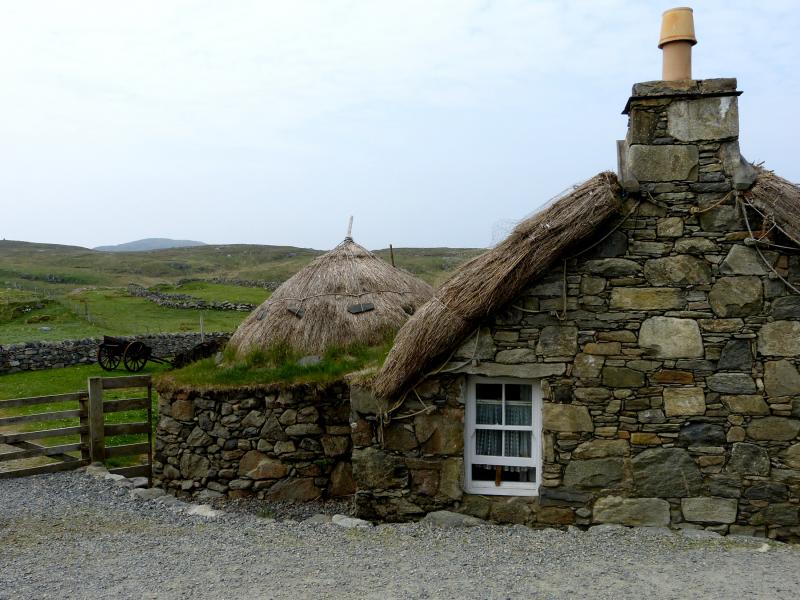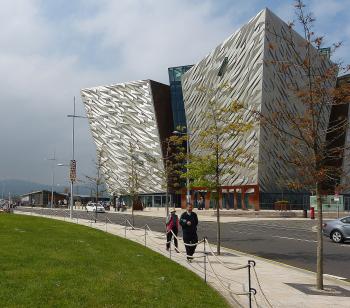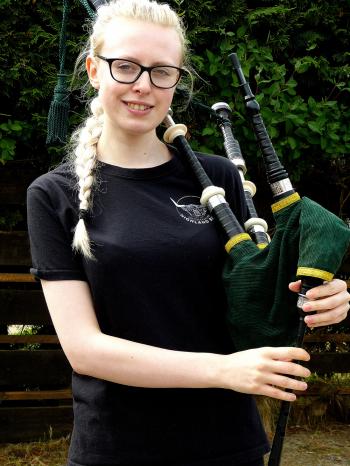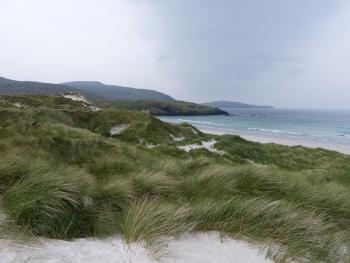Maritime jewels – cruising the British Isles & Ireland
This article appears on page 20 of the October 2018 issue.
It takes a bit of research to find a cruise that carves out but a piece of the world.
Easy to find are those that offer a seafaring smorgasbord — go to bed in Naples, wake up in Marseilles, next stop the Canary Islands — but, when considered carefully, it becomes apparent that what's being offered is all appetizers, no main course. Lacking is the in-depth travel experience.
That type of cruise experience, I've learned, is more likely to occur when one steps aboard a vessel sized to duck into ports that are inaccessible to the big guys. Luckily, my research turned up Grand Circle Cruise Line's 15-day, London-to-Edinburgh voyage "Maritime Jewels of the British Isles & Ireland" aboard the 49-stateroom small ship M/V Corinthian, which is the perfect size to do just that.
An introduction
Passengers would meet in London for transport to Poole, where we'd step aboard to set sail for the Isles of Scilly. From there we'd follow the sea northward, with stops in Wales before crossing the Irish Sea to Ireland and Northern Ireland. The route would continue north into the Outer Hebrides, with the more-northerly Orkney's archipelago next to come, then, making the turn south, we'd follow the east coast of mainland Scotland to Aberdeen before continuing to Edinburgh.
Though I'd been to England, Wales, Ireland, Northern Ireland and Scotland before, it was by land, with my heart in my throat as I drove hedgerow-bordered lanes on the "wrong" side of the road. On this June 2018 trip, I'd arrive by sea, where a tour coach would await at every port of call with a driver at the wheel born to know that the "right" side of the road is the left.
Our meeting place in London was the Tower Hotel, situated at the edge of the Tower of London and St. Katharine Docks. I entered my room with delight; out my window, perfectly framed, was the Tower Bridge.
With all passengers gathered, we met for dinner at The Dickens Inn, a lively pub a short stroll away in the St. Katharine Docks. Once a 19th-century commercial dock and warehouse area, this yacht-filled marina is now lined with trendy restaurants.
Between courses, the four leaders who would be with us throughout the voyage introduced themselves — two women, Charley Bennett and Angela Heerey, and two men, Craig Simpson and George Bareham. George was designated the overall trip leader, but they all had extensive guiding experience and all hailed from the UK.
During the introductions, I was struck by something Craig Simpson said: "You'll find yourself off the beaten track, peeking behind the curtains, getting under the skin of local issues and opinions."
Yes! That's what small-ship cruising — in fact, all travel — should be about!
Each of the 94 travelers on board was preassigned to one of four color-coded groups, noted by a dot on each of our name badges. My dot, green, told me that I'd be following George during our 15 days together.
Looking around London
With a group of others arriving, pre-trip, in London, I'd followed George into East London's Whitechapel district. Known as the once-slum neighborhood where Jack the Ripper hung out, today the district is known for its Bangladeshi community, with the first wave of Bangladeshis arriving in the 1970s. Across from the East London Mosque, we popped into a Muslim shop, where the owner told us about his wares, ranging from clothing to children's books introducing the Qur'an.
Whitechapel, we learned from George, has become popular with London's edgy crowd, who are drawn to the area's ethnic restaurants, markets and art scene.
On Brick Lane, what began as impromptu, street-art graffiti has mushroomed into a venue for artists from all over the UK and beyond to turn entire buildings into canvases. Art galleries for smaller works followed.
One need look no further than the upscale chocolate shop we came across to know that this district is on the road to becoming something else.
The next day offered an opportunity to visit a second London district teetering on the edge of change, Brixton. Craig, who called Brixton home for a number of years, led the way.
Unlike Whitechapel, Brixton started out in the 1880s as an enclave for a prosperous middle class. Change began in the early part of the next century with the gradual conversion of grand houses into flats to accommodate a growing working class. Today, Brixton is largely an African-Caribbean community. The first big wave of British African-Caribbean immigrants, known as the "Windrush generation," arrived in 1948.
So close-knit is Brixton that it's issued its own currency, the Brixton Pound, which is available for use in local, independent shops and businesses.
For many of the same reasons as in Whitechapel, Brixton, with its ethnic restaurants and markets and the stately streets of homes reminiscent of its early days, is attracting a surge of newcomers.
Is it revitalization or displacement gentrification? That was a question to ponder during the coach-ride transfer to the Corinthian, waiting at the dock in Poole.
The ship
Coincidentally, I'd sailed aboard this yacht-like vessel before, in 1992, when it was part of Renaissance Cruises' fleet. Inside, the décor had changed, as expected, but the original rubbed-rosewood walls and the trimmings of gleaming brass remained. Staterooms each featured plentiful mirrors, queen-sized bed, a compact sitting room, spacious closet space, complimentary Wi-Fi and a bath with original teak flooring.
Captain Yaroslav Gonta, hailing from the Ukraine, headed a 65-person crew manifest that read like a roll call of the world — Italy, Croatia, Indonesia, India, Chile, Russia, Egypt and on it went. As for the passengers, all were from the US.
Sailing through the night, as we did throughout the cruise, we dropped anchor off Tresco, the second largest of the more than 140 Isles of Scilly.
Mike Nelhams, curator of the Tresco Abbey Garden, which we would visit later that day, came aboard. Mike, who arrived at the island in 1974 as a horticultural student, told us about the subtropical garden, first planted in the 1830s, where some 20,000 different plant species now flourish.
This excursion involved our only tendered landing. On others, we disembarked directly on shore, where coaches for the four color-coded groups waited. Each group experienced the day's complete itinerary but at different times, ensuring uncrowded visits for everyone.
A local guide was assigned to each coach. Around our necks we wore "whispers" (remote listening devices), eliminating the need to crowd close to the guide and allowing us to wander about without missing a word.
While in Wales
Continuing on to Wales, we next visited Fishguard, a fishing village with a population of fewer than 3,500. A room in the village's Town Hall was devoted to a 100-foot-long embroidered tapestry commemorating the local repelling of an invasion by the French in 1797. A number of the 70 women who created the work were there to meet us, proudly pointing out the scenes they'd embroidered and sharing what the existence of the tapestry means to the community.
Arrangements had been made for home-hosted lunches that day, with Fishguard townspeople opening their doors to welcome as few as three, others as many as eight, around their dining tables.
While all the local guides who shared their part of the world with George's "green" group were excellent, Peta Rodger was a Wales standout. At Caernarfon Castle, constructed by Edward I in 1283, Peta engagingly returned us to the time when the medieval fortress offered the latest in architectural innovations and sumptuous interior amenities.
A slate dais centers the castle's courtyard. With Peta, we stood on the dais, picturing the day in 1969 when Prince Charles was invested as the Prince of Wales by Her Majesty, his mother, Queen Elizabeth II.
Ironically, it was also in 1969 that the great Dinorwic slate quarry, which employed some 3,000 men in its heyday, was shuttered. Since then, the quarry's huge workshops have been developed into the National Slate Museum.
The caban (canteen) was laid out as if waiting for workers to wander in. Much more than a mess hall, as a museum guide told us, it was a place where debates were held, sporting teams organized and union activities were discussed.
We tucked into a typical workman's lunch: vegetable stew, cooked in huge pots on the canteen stove and dished up with bread and butter, with cheese served alongside. Pots of tea were readily available.
That evening, a Welsh choir came aboard the Corinthian to share the tradition that began in the slate and coal mines of men raising their voices in four-part harmony.
Other evening entertainment included a Welsh harpist accompanying herself in song and a pair of Irish dancers who provided a Riverdance-worthy performance while we were docked in Dublin, and, in Scottish waters, a local dancing school contributed their kilt-garbed students, the youngest an endearing 4-year-old.
Northern Ireland and beyond
Several predinner gatherings were devoted to political subjects of importance to the UK. At one, a member of the Scottish parliament discussed the position in which Scotland finds itself. After having voted against independence, Scotland is now unexpectedly embroiled in Brexit. Is a second referendum for independence in the works?
As for Northern Ireland's politics, in Belfast we took to the streets. At the dock, a parade of the city's black cabs awaited, each with a cabbie at the wheel who had lived through The Troubles.
"Take us to wherever we should go," I said, as our group of four entered David Groves' cab. "Ah," he said jokingly, "then it's off to the pub!"
Instead, with David providing the narrative, which included personal stories, we visited Belfast's iconic locations of conflict. Included was a stop at one of the "peace walls" that continue to separate neighborhoods, even though the near-30-year conflict came to its uneasy end in 1998.
In the afternoon, there was a choice to be made: a guided walk through the city center, which has emerged from being a dark and deserted place to becoming a jewel of restored Victorian architecture and trendy boutiques, or a visit to the Titanic Museum, an award-winning, aluminum-clad structure situated on the ship's building site.
I chose to visit the museum's six floors of construction-to-sinking interactive exhibits. How could I resist, given that my visit was on May 31, marking to the day the ship's launching 107 years ago?
The calm seas and unthreatening skies with which the Corinthian was gifted since its departure from Poole continued as we made our way north to Barra, a dot at the foot of the Outer Hebrides chain (known to aficionados of black-and-white movies as the filming site of "Whisky Galore!," aka "Tight Little Island").
Docked at Castlebay, with the ruins of Kisimul Castle glowering from a rock alongside, our exploration of the island included a walk over dunes to a white-sand curve of beach, where those who wished to dipped their feet into Barra's crystal-clear, Caribbean-hued sea.
A ceilidh — a gathering featuring music, song and dance — was arranged for us that afternoon. With an accordionist providing the tunes, the brave among us took to the community hall's dance floor to attempt the steps of a traditional dance, adding unintentional bumping into others to the entertainment.
Orkney Islands
Sailing farther north, we entered the Orkney Islands, situated between the North Sea and the Atlantic, to dock at the small fishing village of Stromness. Local guide Roger Davies awaited my "green" group.
Roger defined the Orkneys as a place of grass and stone isolated from the rest of the world by wind and weather. "We expect a gale every 13 days," he said. "So fierce are the winds that when they stop, the people all fall over."
But there was no need to push against a gale during our visit. Puffy clouds drifted through a slightly gray sky, with just a slight chill in the air.
As we drove through the countryside's green fields interspersed with clumps of red poppies and stands of bluebells, Roger pointed out with pride the wind turbines that provided electricity for the entire population of 20,000 (if one does not include the 80,000 head of cattle and 120,000 sheep).
Crossing a causeway built by WWII Italian POWs, who were transported in 1942 from the heat of the North African desert to the freezing cold of an Orkney winter, Roger took us to an icon of hope, inspiration and peace that came out of that war.
With a talented POW artist's guidance, the prisoners joined two Nissen (Quonset) huts together with the goal of using bits and pieces of salvaged material to build a chapel. Island residents took notice, with one donating concrete for the foundation and another providing brushes and poster paints for the interior. Those inside and outside the barbed wire began to look at each other differently, no longer as enemies.
After the war, the demolition team that was sent to take down the camp refused to touch the converted huts.
Today, the Italian Chapel remains standing in the field. The artistic detailing of its interior took my breath away. Who would guess that the intricate hanging lanterns were made from corned-beef tins?
Looking back
While unusual and unexpected experiences marked each day of our cruise, the "beaten track" was not ignored. In London, we walked through St. James' Park, pausing for a "class picture" in front of Buckingham Palace.
At Trinity College Library in Dublin, we tried our best to view the Book of Kells through the throngs that crowded the exhibit, even though admissions were timed to help avoid such an experience.
In Scottish territory, we paid the obligatory visit to a single-malt distillery, with liberal tastings enjoyed by all. In Edinburgh, we walked the touristy Royal Mile, but, even there, we followed our guide into a dark alley to find the surprise of a quiet garden far removed from the madding crowd.
My encounters with local residents — who shared their pride of place and their concerns about the future as they took us to the nooks and crannies of their world that I had no idea existed — will remain in my mind.
Cruises of 16 days are scheduled May through September for 2019, with departures alternating between London and Edinburgh. Prices (double occupancy) begin at $7,595 per person.
Yvonne Michie Horn was a guest of Grand Circle Travel (Boston, MA; 800/221-2610, www.gct.com).



-itok=uywikbIN.jpg)

